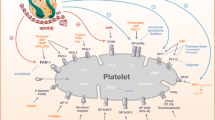Summary
In a study of 20 patients with hypercholesterolemia (type IIa) the effects of lovastatin (20–80 mg/ day) on various clotting and thrombosis parameters were monitored for 12 months. On 11 occasions various cholesterol fractions and clotting parameters were determined in each patient. In additon, the clotting inhibitors AT III, protein C, protein S, and C1-esterase inhibitor and the fibrinolysis parameters plasminogen and α2-antiplasmin were examined. Platelet function was monitored on the basis of spontaneous and induced (collagen, ADP, epinephrine, ristocetin) aggregation. Lovastatin in the above dosage brought about a 66 mg/dl (from 320 ± 12.6 to 254 ± 12.0 mg/dl) reduction in the total cholesterol level and a 56 mg/dl (from 244 ± 11.4 to 188 ± 12.1 mg/dl) reduction in LDL cholesterol at the end of the study. Fibrinogen showed a significance decrease during the study period, whereas PT and aPTT remained unaffected. The initial slopes of the ADP-induced platelet aggregation revealed a significant decrease. C-reactive protein and platelet count remained within the normal range, indicating no significant change. Thrombin clotting time, AT III, Cl-esterase inhibitor, plasminogen, and α2-antiplasmin were not modified. Protein C and S behaved in a contradictory way, but remained within the normal range. Long-term treatment with lovastatin was associated with a significant reduction of fibrinogen levels and platelet aggregation induced by ADP in type-IIa hypercholesterolemic patients. These alterations, as well as their role in cardiovascular disease, should be the subject of further investigations.
Similar content being viewed by others
References
Aviram M, Brook JG (1987) Platelet activation by plasma proteins. Prog Cardiovasc Dis 30: 61–72
Beigel Y, Fuchs J, Snir M, Green P, Lurie Y, Djaldetti M (1991) Lovastatin therapy in hypercholesterolemia: effect on fibrinogen, hemorrheologic parameters, platelet activity and red blood cell morphology. J Clin Pharmacol 31: 512–517
Born GVR (1963) The aggregation of blood platelets. J Physiol 168: 178
Breddin HK, Hach-Wunderle V (1987) Gerinnungsphysiologische Untersuchungen bei der tiefen Venenthrombose. Internist 28: 308–316
Brown MS, Goldstein JL (1985) Nobel lecture. Science 232: 34–47
Carvalho ACA, Colman RW, Lees RS (1974) Platelet function in hyperlipoproteinemia. N Engl J Med 290: 434–438
Davi G, Averna M, Novo S, Barbagallo CM, Mogavero A, Notarbartolo A, Strano A (1989) Effects of synvinolin on platelet aggregation and thromboxane B2 synthesis in type IIa hypercholesterolemic patients. Atherosclerosis 79: 79–83
Eynard AR, Tremoli E, Caruso D, Magni F, Sirtori CR, Galli G (1985) Platelet formation of 12-hydroxyeicosategraenoic acid and thromboxane B2 is increased in type-II a hypercholesterolemic subjects. Atherosclerosis 60: 61–66
Fredrickson DS, Lees RS (1965) A system for phenotyping hyperlipoproteinemia. Circulation 31: 321
Friedewald WT, Levy RJ, Fredrickson DS (1972) Estimation of the concentration of low-density lipoprotein cholesterol in plasma, without use of the preparative ultracentrifuge. Clin Chem 18: 499
George JN, Shattil SJ (1991) The clinical importance of acquired abnormalities of platelet function. N Engl J Med 324: 27–39
Havel RJ, Hunninghake DB, Illingworth DR (1985) Mevinolin in the therapy of familial hypercholesterinemia. Circulation 72 [Suppl 3]: 198
Jones PH (1990) Lovastatin and Simvastatin prevention studies. Am J Cardiol 66: 39B-43B
Kienast J, Berning B, van de Loo J (1990) Fibrinogen as risk indicator of arteriosclerotic alterations and coronary heart disease. Diagn Lab 40: 162
Koppensteiner R, Minar E, Ehringer H (1990) Effect of lovastatin on hemorheology in type-II hyperlipoproteinemia. Atherosclerosis 83: 53–58
Korninger C (1985) Hypofribrinolyse und venöse Thrombophilie. Hämostaseologie 5: 144–149
Mantell G, Burke M, Staggers J (1990) Extended clinical safety profile of lovastatin. Am J Cardiol 66: 11B-15B
Multicenter study (1986) Therapeutische Wirkung von Lovastatin bei primärer nichtfamiliärer Hypercholesterinämie. JAMA 256: 2829–2834
Multicenter study (1987) Lovastatin in the treatment of heterozygous familial hypercholesterinemia. Ann Intern Med 107: 609–615
Nutrition Committee and Council on Atherosclerosis (1984) Recommendations for treatment of hyperlipidemia in adults — a joint statement. Circulation 69: 1067A-1090A
Padro T, Villaverde CA, Canovas M (1988) Hyperlipidemia, fibrinolysis and atherosclerosis. Thromb Res 49: 519–530
Riess H, Merk W, Falkner C, Hiller E (1986) Increased in vitro platelet aggregation in hypertriglyceridemias. Thromb Res 37: 281–289
Salvi A (1990) Serum lipids and coagulative parameters during simvastatin treatment in type-II a hyperlipidemia. European Atherosclerosis congress, Oct. 10–13: 275 (abstract book)
Scharrer I (1986) Untersuchungsprogramm bei Verdacht auf Thrombophilie. Ellipse 9: 12
Schrör K (1988) Lexikon der Prostaglandine. Medikon, München
Schrör K, Löbel P, Steinhagen-Thiessen E (1989) Simvastatin reduces platelet thromboxane formation and restores normal platelet sensitivity against prostacyclin in type-IIa hypercholesterolemia. Eicosanoids 2: 39–45
Schwandt P (1985) Triglyceride-rich lipoproteins and atherosclerosis. Fortschr Med 102: 683
Seidel D (1978) Pathogenese der Atherosklerose. Sonderdruck aus Laboratoriumsmedizin, Ausgabe 3
Seidel D, Cremer P, Thiery J (1985) Plasmalipoproteine and Atherosklerose. Int Welt 8: 114–124, 159–165
Steinberg D (1987) Lipoproteins and the pathogenesis of atherosclerosis. Circulation 76: 508–514
Thaler E (1982) AT III-Mangel und Thrombophilie. Hämostaseologie 5: 127
Tobert JA (1987) New developments in lipid-lowering therapy: the role of inhibitors of HMG-CoA reductase. Circulation 76: 534–538
Tobert JA (1988) Efficacy and long-term adverse effect pattern of lovastatin. Am J Cardiol 62: 28J-34J
Witt I (1990) The clinical relevance of protein C. Diagn Lab 40: 154
Zucker ML, Trowbridge C, Krehbiel P, Jackson B, Chernoff SB, Dujovne CA (1986) Platelet function in hypercholesterolemics before and after hypolipidemic drug therapy, Haemostasis 16: 57–64
Author information
Authors and Affiliations
Rights and permissions
About this article
Cite this article
Mayer, J., Eller, T., Brauer, P. et al. Effects of long-term treatment with lovastatin on the clotting system and blood platelets. Ann Hematol 64, 196–201 (1992). https://doi.org/10.1007/BF01696223
Received:
Accepted:
Issue Date:
DOI: https://doi.org/10.1007/BF01696223




